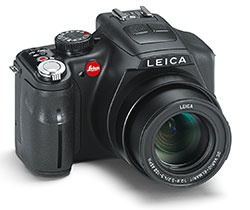By Steve Baczewski
Bordering the world of DSLRs — and sharing many of the same sophisticated features — is a breed of high-end, compact, point-and-shoot cameras. Leica (www.leica.com) has released one of those: their new V-Lux 3.
Although the V-Lux 3 doesn’t introduce any major new technology, it’s packed with features and its centerpiece is a versatile 24x zoom lens. The DC Vario-Elmarit lens is 4.5–108mm, f/2.8–5.2, and its range is the 35mm equivalent of 25–600mm. That’s a vast reach for stills and very handy for shooting HD videos at 1920×1080 pixels and 60 fps.
Although the V-Lux 3 won’t fit in a shirt pocket, it’s light and compact enough to carry over your shoulder or in a large coat pocket all day without feeling burdened. It’s nicely balanced with a deep, rubberized grip that makes it easy to hold steady with its image-stabilized lens fully extended. The camera controls are well designed. The grip leaves your thumb and index finger with easy access to the shutter, zoom lever, and dedicated movie trigger button. There’s a second zoom control located near the lens barrel on the left side.
Many frequently used features can be accessed quickly onscreen without scrolling the menus. You can compose subjects by toggling between the electronic viewfinder (EVF) and 3″ articulated LCD, as both display pertinent shooting data, including a live histogram. The 460,000-dot resolution LCD holds up well in bright light. The mode dial has all the conventional settings plus 18 preset scene modes and a custom function. The 1/2.33″ sensor is 12.8 megapixels overall, but effectively reduced to 12.1 when cropped using the camera’s aspect ratios of 4:3, 3:2, 16:9, and 1:1.
Despite the sensor’s relatively small size (factor of 5.5), the image quality is quite good throughout the range of the lens—no pin cushioning and only a slight amount of vignetting at wide apertures. The V-Lux-3 shoots RAW and JPEG files capable of making tabloid-size prints, and the files were sharp with good color, lots of shadow/highlight detail, and a surprisingly wide dynamic range.
Great for sports or fast action, the V-Lux 3 shoots 12 RAW files per second in continuous mode, with minimum shutter lag and in between shot time. The EVF/LCD refresh quickly, with virtually no streaking. The camera’s contrast-detection autofocus was generally fast; however, it occasionally hesitated or was slow—even in situations with distinct contrast.
A live histogram helps optimize exposures and if an exposure is in excess of the dynamic range, the camera’s auto-bracketing mode helps you to do HDR photography. The auto bracketing lets you take three exposures up to 3 stops under and over in increments of 1/3 stop—nice! The zoom lens moves smoothly for its entire range and responds quickly, stopping at the desired focal length.
The V-Lux 3 also has a built-in flash and a hot shoe for either optional external flash or microphone.
In a market of cameras with extended ISOs in excess of 12,500, the range of the V-Lux 3 is a modest 100–3,200, with noise becoming obvious at 800, and an issue at 3,200. (The noise cleaned up nicely, however, using the noise-reduction sliders in Lightroom.)
One caveat: The camera is manufactured by Panasonic, rebadged by Leica, and is essentially identical to the Panasonic DMC-FZ150. Depending on where you buy it, the Leica is approximately $425 more, but the deal is fattened with electronic downloads of Adobe Photoshop Elements and Premiere Elements. The V-Lux 3 is a good camera for stills and movies but I have a hard time fully embracing it at its current price of US$949.
Rating: 7 out of 10
(This review is brought to you courtesy of “Layers Magazine”: http://layersmagazine.com/ .)



